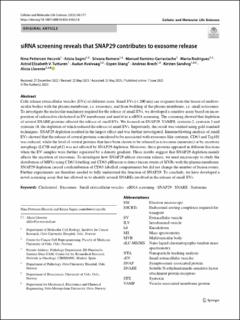| dc.contributor.author | Hessvik, Nina Pettersen | |
| dc.contributor.author | Sagini, Krizia | |
| dc.contributor.author | Romero, Silvana Angelica Troncoso | |
| dc.contributor.author | Ramirez, Manuel | |
| dc.contributor.author | Rodriguez, Marta | |
| dc.contributor.author | Tutturen, Astrid Elisabeth Voorham | |
| dc.contributor.author | Kvalvaag, Audun Sverre Myrset | |
| dc.contributor.author | Stang, Espen | |
| dc.contributor.author | Brech, Andreas | |
| dc.contributor.author | Sandvig, Kirsten | |
| dc.contributor.author | Llorente, Alicia | |
| dc.date.accessioned | 2024-01-19T08:16:36Z | |
| dc.date.available | 2024-01-19T08:16:36Z | |
| dc.date.created | 2023-06-26T10:38:22Z | |
| dc.date.issued | 2023 | |
| dc.identifier.citation | Cellular and Molecular Life Sciences (CMLS). 2023, 80 . | en_US |
| dc.identifier.issn | 1420-682X | |
| dc.identifier.uri | https://hdl.handle.net/11250/3112645 | |
| dc.description.abstract | Cells release extracellular vesicles (EVs) of different sizes. Small EVs (< 200 nm) can originate from the fusion of multive-
sicular bodies with the plasma membrane, i.e. exosomes, and from budding of the plasma membrane, i.e. small ectosomes.
To investigate the molecular machinery required for the release of small EVs, we developed a sensitive assay based on incor-
poration of radioactive cholesterol in EV membranes and used it in a siRNA screening. The screening showed that depletion
of several SNARE proteins affected the release of small EVs. We focused on SNAP29, VAMP8, syntaxin 2, syntaxin 3 and
syntaxin 18, the depletion of which reduced the release of small EVs. Importantly, this result was verified using gold standard
techniques. SNAP29 depletion resulted in the largest effect and was further investigated. Immunoblotting analysis of small
EVs showed that the release of several proteins considered to be associated with exosomes like syntenin, CD63 and Tsg101
was reduced, while the level of several proteins that have been shown to be released in ectosomes (annexins) or by secretory
autophagy (LC3B and p62) was not affected by SNAP29 depletion. Moreover, these proteins appeared in different fractions
when the EV samples were further separated by a density gradient. These results suggest that SNAP29 depletion mainly
affects the secretion of exosomes. To investigate how SNAP29 affects exosome release, we used microscopy to study the
distribution of MBVs using CD63 labelling and CD63-pHluorin to detect fusion events of MVBs with the plasma membrane.
SNAP29 depletion caused a redistribution of CD63-labelled compartments but did not change the number of fusion events.
Further experiments are therefore needed to fully understand the function of SNAP29. To conclude, we have developed a
novel screening assay that has allowed us to identify several SNAREs involved in the release of small EVs. | en_US |
| dc.language.iso | eng | en_US |
| dc.rights | Navngivelse 4.0 Internasjonal | * |
| dc.rights.uri | http://creativecommons.org/licenses/by/4.0/deed.no | * |
| dc.title | siRNA screening reveals that SNAP29 contributes to exosome release | en_US |
| dc.type | Peer reviewed | en_US |
| dc.type | Journal article | en_US |
| dc.description.version | publishedVersion | en_US |
| cristin.ispublished | true | |
| cristin.fulltext | original | |
| cristin.qualitycode | 1 | |
| dc.identifier.doi | 10.1007/s00018-023-04822-8 | |
| dc.identifier.cristin | 2157867 | |
| dc.source.journal | Cellular and Molecular Life Sciences (CMLS) | en_US |
| dc.source.volume | 80 | en_US |
| dc.source.pagenumber | 0 | en_US |

